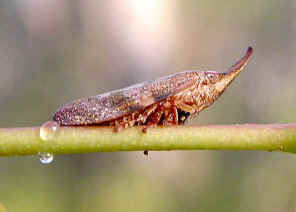Spittlebugs - Family Aphrophoridae
Order Hemiptera
This page contains pictures and information about Spittlebugs of family Aphrophoridae that we found in the Brisbane area, Queensland, Australia.

- Spittlebug nymph
- The insects in this family are known as spittlebugs. Their nymph produces 'spittle' clinging on the stems of shrubs or small trees. They live immersed in masses of those liquid. It is believed that this will reduce the risk of dehydration and to deter parasites. Those spittle is sometimes known as cuckoo-spit. NOT all species in this family form the spittle.
- They are sapsuckers which feed on the leaves, twigs, branches and/or trunk of the host trees. They insert their needle-like stylets into plant tissue to feed. They lay eggs in plant tissue. Adults are strong jumpers.
- Common Spittlebug



- Philagra parva, body length 8mm
- The insect adult has a narrow curved horn on the front of the head. Its is brown in colour. This Spittlebug in common in Brisbane bushes. Their nymphs produce 'spittle' clinging to the stems of shrubs or small trees to reduce the risk of dehydration or/and to deter parasites. Those spittle is sometimes known as cuckoo-spit. We have more pictures and information in this page.
- Black Spittlebug


- Amarusa australis, body length 10mm
- Pictures were taken in Yugarapul Park Nov 2008. The Black Spittlebug is dark-brown to golden-black in colour. It has a speed-boat shape head. More information can be found in this page.
- Reference:
- 1. Insects of Australia, CSIRO, Division of Entomology, Melbourne University Press, 2nd Edition 1991, pp 468.
- 2. Review of the Australian aphrophorid spittlebugs (Hemiptera: Aphrophoridae) - Liang, A.P. and Fletcher, M.J. (2003), Australian Journal of Entomology 42(1): 84-93.
- 3. Auchenorrhyncha keys - Fletcher, M.J. (2009 and updates). Identification keys and checklists for the leafhoppers, planthoppers and their relatives occurring in Australia and neighbouring areas (Hemiptera: Auchenorrhyncha).
